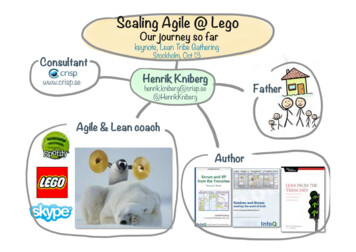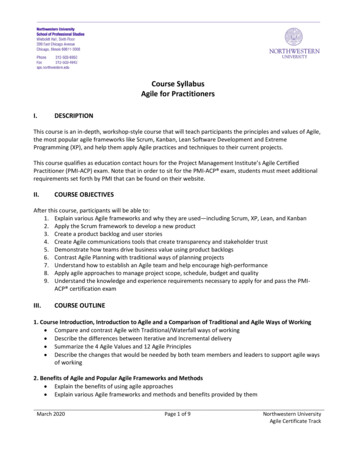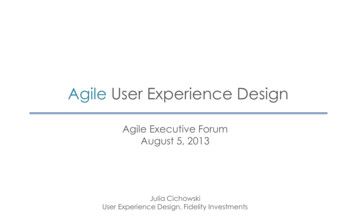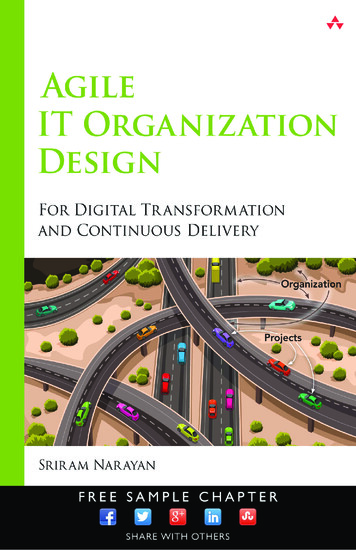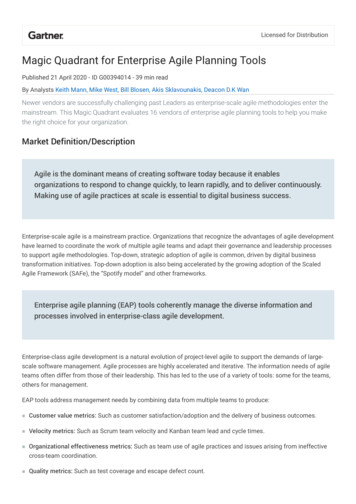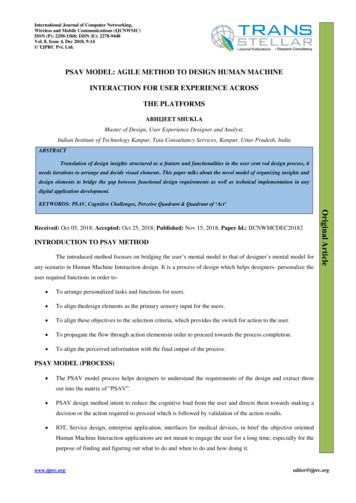
Transcription
International Journal of Computer Networking,Wireless and Mobile Communications (IJCNWMC)ISSN (P): 2250-1568; ISSN (E): 2278-9448Vol. 8, Issue 4, Dec 2018, 9-14 TJPRC Pvt. Ltd.PSAV MODEL: AGILE METHOD TO DESIGN HUMAN MACHINEINTERACTION FOR USER EXPERIENCE ACROSSTHE PLATFORMSABHIJEET SHUKLAMaster of Design, User Experience Designer and Analyst,Indian Institute of Technology Kanpur, Tata Consultancy Services, Kanpur, Uttar Pradesh, IndiaABSTRACTTranslation of design insights structured as a feature and functionalities in the user cent red design process, itneeds iterations to arrange and decide visual elements. This paper talks about the novel model of organizing insights anddesign elements to bridge the gap between functional design requirements as well as technical implementation in anydigital application development.KEYWORDS: PSAV, Cognitive Challenges, Perceive Quadrant & Quadrant of ‘Act’INTRODUCTION TO PSAV METHODThe introduced method focuses on bridging the user’s mental model to that of designer’s mental model forany scenario in Human Machine Interaction design. It is a process of design which helps designers- personalize theOriginal ArticleReceived: Oct 05, 2018; Accepted: Oct 25, 2018; Published: Nov 15, 2018; Paper Id.: IJCNWMCDEC20182user required functions in order to To arrange personalized tasks and functions for users. To align thedesign elements as the primary sensory input for the users. To align these objectives to the selection criteria, which provides the switch for action to the user. To propagate the flow through action elementsin order to proceed towards the process completion. To align the perceived information with the final output of the process.PSAV MODEL (PROCESS) The PSAV model process helps designers to understand the requirements of the design and extract themout into the matrix of “PSAV”. PSAV design method intent to reduce the cognitive load from the user and directs them towards making adecision or the action required to proceed which is followed by validation of the action results. IOT, Service design, enterprise application, interfaces for medical devices, in brief the objective orientedHuman Machine Interaction applications are not meant to engage the user for a long time, especially for thepurpose of finding and figuring out what to do and when to do and how doing it.www.tjprc.orgeditor@tjprc.org
10Abhijeet ShuklaFigure 1: PSAV Process and Key Reasoning PointsPHILOSOPHY OF THE METHODFor completion of any process the cognitive challenges of what, why, where & when put unnecessary cognitiveload on the users which hinder the decision of selection.It is a set of a process model and a matrix which provides a guidedpath towards the visibility of the content for the user to operate/interact with.There is no one way to practice design methods. John Chris Jones once recognized this by stating:"Methodology should not be a fixed track to a fixed destination, but a conversation about everything that could bemade to happen. The language of the conversation must bridge the logical gap between past and future, but in doing so itshould not limit the variety of possible futures that are discussed nor should it force the choice of a future that is unfree."PSAV method focuses on minimizing the diversions for the user by providing the simple interactions andinterface points.The philosophical purpose of this method is to develop a strategy in design operations in the competitiveexistence of the products, for managing design related requirements, too fast process the design meta steps.PSAV MODEL MATRIXIn this section paper talks about the Model matrix, an illustration of the matrix is shown in Figure 2 below.Figure 2: PSAV Data Arrangement Model Matrix Quadrant of ‘Perceive’: In this quadrant designers are supposed to write all the elements which convey- Objective of the interactive process Required interaction for the userImpact Factor (JCC): 7.9083NAAS Rating: 3.71
PSAV Model: Agile Method to Design Human MachineInteraction for User Experience Across the Platforms Functionalities that lead towards the next step of the process. Interactive, functional, objective, specific information in any media format suitable for the user.11The purpose of this Perceive quadrant is to classify and chart out all the requirements/needs which may leadtowards the process initiation. The elements in the perceive quadrant have the basic characteristics of defining “What” theuser should perceive Quadrant of ‘Select’: A design can have as many perspectives as many user there could be, but for certain thereare at least two perspectives, one of the designer’s and one of the user’s. Shortest route of jumping to the next stepof the process must be available for the user. As shown in fig- 1PSAV method has applicability in defining anyapplication of multiple layers. These layers can comprise of three basic kinds- Flow system Meta process of User flow Interaction definitionThe purpose of this quadrant is to organize the keys/Switches which are meant to initiate anactive process. It canbe identified as the trigger for the action initiation. These trigger receive the command from the user to proceed to the nextstep. These triggers are inventive in nature and must be able, to interact with the user as well as capture the exactinteractive commands in response. Quadrant of ‘Act’: It is a progressive section of ‘select’, where a selection has been made by a user and nowsystem is required to produce/ present the correct actionable interaction or information to proceed. The actions canbe as follows- Arrangement of actions requirements Type of actions Action sequence Quadrant of Validation: Once an action has been performed system should be able to validate the action results.This validation must also be extended to the user in the preferred perceivable format. In this section the validationkey, commands and messages in the format preferable to users are required to be present.COMPATIBILITY ESTABLISHMENTPSAV model is an agile design methodologywhich enables a designer to createa highly interactive system designat the macro and micro level as shown in Figure 3. PSAV process has its applicability in the area of user experience designand concerned areas of Human Computer Interaction design. Key compatibilities of the method are listed below PSAV method is compatible withthe Lean Framework of development. PSAV method is compatible with Agile Framework PSAV method is compatible User centric design processwww.tjprc.orgeditor@tjprc.org
12Abhijeet ShuklaFigure 3: Micro Modelling and Proofing of the Design SolutionCONCLUSIVE VALIDATIONThis section refers to the experiment published by the author for the application of Perceive –Select- Act- Validatemethod without actually describing the actual method. A set of process optimization exercises were conducted andrecorded as a part of this experiment. The information collected from the experiment was further analyzed for itsapplicability. Process optimization is considered one of the pillars of the user experience design. PSAV modelmethodology was tested for improving the user experience in this set of experiment. As shown in the Figure 4 below, it canbe observed that a significant reduction in the process steps were achieved through the PSAV model methodologyapplication in user experience design process.Figure 4: Result of Process Optimization ExerciseThe output of the experiment supports the applicability of PSAV method in the area of user experience design.It shall be noted here that a well-defined problem statement and meaningful insights supports the agile implementation ofthe PSAV method. It was also empirical during the experiment that to apply the PSAV model contextual research orunderstanding is needed on the designer’s part.APPLICATION AREASApplication of PSAV method can effectively be utilized inHuman Computer Interaction Design,Interaction andinterface design for IOT devices, Mobile web application, interface and interaction design, system design, medical deviceImpact Factor (JCC): 7.9083NAAS Rating: 3.71
PSAV Model: Agile Method to Design Human MachineInteraction for User Experience Across the Platforms13design, however not limited to.It is also helpful in the development phase of any project concerningthe digital applicationof information technology.REFERENCES1.Elito Method, rsal Methods of Design: 100 Ways to Research Complex Problems, Develop Innovative Ideas, and Design EffectiveSolutions3.Agile method, https://www.scruminc.com/scrum-blog/4.KJ Technique, https://articles.uie.com/kj technique/5.Kano Aanalysis, https://en.wikipedia.org/wiki/Kano model6.The Gita-in contemporary times; Relevant and applicable for designers, 2018 JETIR May 2018, Volume 5, Issue 5www.jetir.org (ISSN-2349-5162)7.Determination of Inflation Steps for Rubber Inflatable Seal Using FE Analysis, International Journal of Engineering Scienceand Computing, December 2017 156948.Don’t make me think, Steve Kurg, Pearson ISBN 978-93-325-42869.Application of PSAV method in interaction steps optimization for user experience design, IJARIIT ISSN: 2454-132X, Vol.4,Issue 5Author DetailsAuthor is the inventor of PSAV Method, he is an active design researcher and strategist. He is an alumnus of theIndian Institute of Technology Kanpur. He is currently associated with Tata Consultancy Services as a User ExperienceAnalyst. Apart from futuristic design research, he is also an explorer of ancient scientific scriptures. He has published bookchapters and research papers in journals of international repute. His research papers have helped several organizations tobuild strategic plans for product usability and user experience.www.tjprc.orgeditor@tjprc.org
PSAV model is an agile design methodologywhich enables a designer to createa highly interactive system design at the macro and micro level as shown in Figure 3. PSAV process has its applicability in the area of user experience design and concerned areas of Human Computer Interaction design





